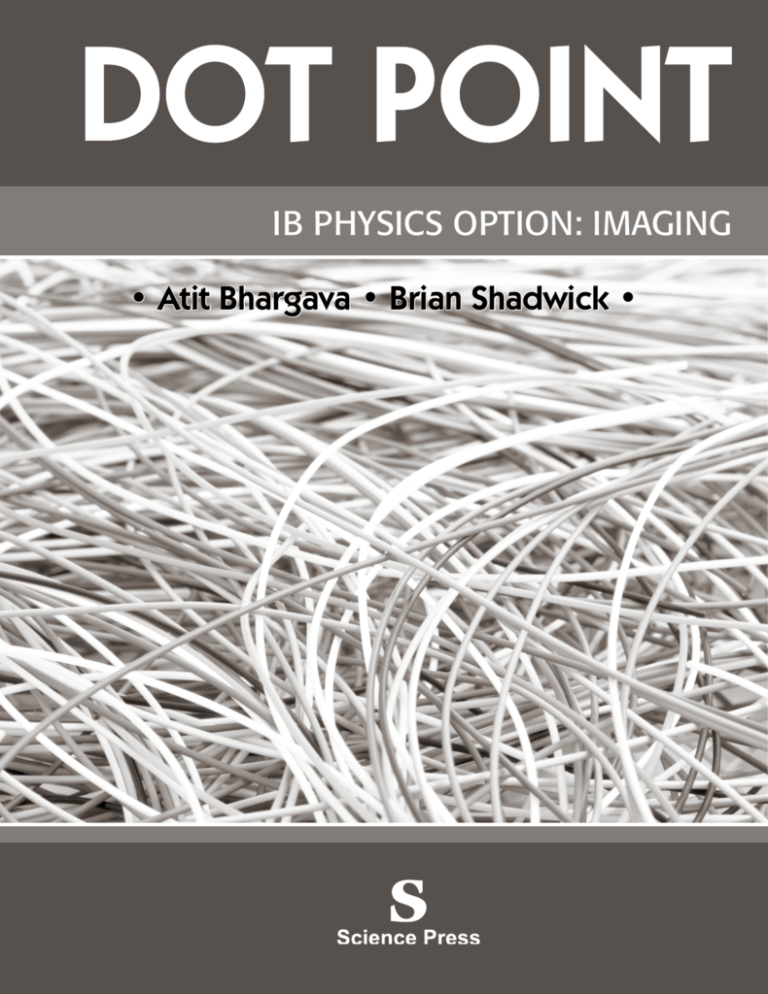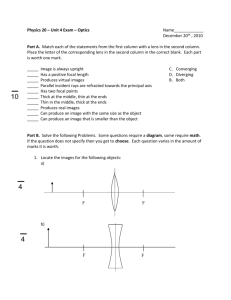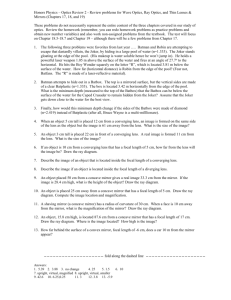
IB PHYSICS OPTION: IMAGING
• Atit Bhargava • Brian Shadwick •
© Science Press 2016
First published 2016
Science Press
Private Bag 7023 Marrickville NSW 1475 Australia
Tel: +61 2 9516 1122 Fax: +61 2 9550 1915
sales@sciencepress.com.au
www.sciencepress.com.au
All rights reserved. No part of this publication
may be reproduced, stored in a retrieval system,
or transmitted in any form or by any means,
electronic, mechanical, photocopying, recording
or otherwise, without the prior permission of
Science Press. ABN 98 000 073 861
Contents
Words to Watch
iv
Introductionv
Dot Points
Introduction to Imaging
vi
Imaging Instrumentation
vi
Fibre Optics
vi
Medical Imaging
vi
Questions
Introduction to Imaging
1
Imaging Instrumentation
19
Fibre Optics
33
Medical Imaging
45
Answers
Introduction to Imaging
60
Imaging Instrumentation
71
Fibre Optics
77
Medical Imaging
81
Appendices
Data Sheet
87
Periodic Table
88
Science Press
Dot Point IB Physics Option: Imaging
iii
Contents
Words to Watch
account, account for State reasons for, report on,
give an account of, narrate a series of events or
transactions.
examine Inquire into.
analyse Interpret data to reach conclusions.
extrapolate Infer from what is known.
annotate Add brief notes to a diagram or graph.
hypothesise Suggest an explanation for a group of
facts or phenomena.
explain Make something clear or easy to understand.
extract Choose relevant and/or appropriate details.
apply Put to use in a particular situation.
assess Make a judgement about the value of
something.
identify Recognise and name.
calculate Find a numerical answer.
clarify Make clear or plain.
investigate Plan, inquire into and draw conclusions
about.
classify Arrange into classes, groups or categories.
justify Support an argument or conclusion.
comment Give a judgement based on a given
statement or result of a calculation.
label Add labels to a diagram.
compare Estimate, measure or note how things are
similar or different.
measure Find a value for a quantity.
construct Represent or develop in graphical form.
plan Use strategies to develop a series of steps or
processes.
interpret Draw meaning from.
list Give a sequence of names or other brief answers.
outline Give a brief account or summary.
contrast Show how things are different or opposite.
predict Give an expected result.
create Originate or bring into existence.
propose Put forward a plan or suggestion for
consideration or action.
deduce Reach a conclusion from given information.
define Give the precise meaning of a word, phrase or
physical quantity.
recall Present remembered ideas, facts or
experiences.
demonstrate Show by example.
relate Tell or report about happenings, events or
circumstances.
derive Manipulate a mathematical relationship(s) to
give a new equation or relationship.
describe Give a detailed account.
represent Use words, images or symbols to convey
meaning.
design Produce a plan, simulation or model.
select Choose in preference to another or others.
determine Find the only possible answer.
sequence Arrange in order.
discuss Talk or write about a topic, taking into account
different issues or ideas.
show Give the steps in a calculation or derivation.
distinguish Give differences between two or more
different items.
solve Work out the answer to a problem.
draw Represent by means of pencil lines.
suggest Put forward an idea for consideration.
estimate Find an approximate value for an unknown
quantity.
summarise Give a brief statement of the main points.
sketch Make a quick, rough drawing of something.
state Give a specific name, value or other brief answer.
synthesise Combine various elements to make a
whole.
evaluate Assess the implications and limitations.
Science Press
Words to Watch
iv
Dot Point IB Physics Option: Imaging
Introduction
What the book includes
This book provides questions and answers for each dot point in the IB Physics Option: Imaging syllabus from
the International Baccalaureate Diploma Programme for Physics:
•
Introduction to Imaging
•
Imaging Instrumentation
•
Fibre Optics
•
Medical Imaging
Format of the book
The book has been formatted in the following way:
1.1 Subtopic from syllabus.
1.1.1
Assessment statement from syllabus.
1.1.1.1 First question for this assessment statement.
1.1.1.2 Second question for this assessment statement.
The number of lines provided for each answer gives an indication of how many marks the question might be
worth in an examination. As a rough rule, every two lines of answer might be worth 1 mark.
How to use the book
Completing all questions will provide you with a summary of all the work you need to know from the syllabus.
You may have done work in addition to this with your teacher as extension work. Obviously this is not covered,
but you may need to know this additional work for your school exams.
When working through the questions, write the answers you have to look up in a different colour to those you
know without having to research the work. This will provide you with a quick reference for work needing further
revision.
Science Press
Dot Point IB Physics Option: Imaging
v
Introduction
Dot Points
Imaging
C1
C.1.1
C.1.2
C.1.3
C.1.4
C.1.5
C.1.6
C.1.7
Introduction to Imaging
Thin lenses.
Converging and diverging lenses.
Converging and diverging mirrors.
Ray diagrams.
Real and virtual images.
Linear and angular magnification.
Spherical and chromatic aberrations.
2
2
2
4
5
5
5
16
Answers to Introduction to Imaging
60
C2
C.2.1
C.2.2
C.2.3
C.2.4
C.2.5
C.2.6
20
20
26
29
30
30
31
Imaging Instrumentation
Optical compound microscopes.
Simple optical astronomical refracting telescopes.
Simple optical astronomical reflecting telescopes.
Single-dish radio telescopes.
Radio interferometry telescopes.
Satellite-borne telescopes.
Answers to Imaging Instrumentation
71
C3
C.3.1
C.3.2
C.3.3
C.3.4
C.3.5
34
34
35
38
39
40
Fibre Optics
Structure of optic fibres.
Step-index fibres and graded-index fibres.
Total internal reflection and critical angle.
Waveguide and material dispersion in optic fibres.
Attenuation and the decibel (dB) scale.
Answers to Fibre Optics
77
C4
C.4.1
C.4.2
C.4.3
46
46
53
Medical Imaging
Detection and recording of X-ray images in medical contexts.
Generation and detection of ultrasound in medical contexts.
Medical imaging techniques (magnetic resonance imaging) involving nuclear magnetic
resonance (NMR).
Answers to Medical Imaging
56
81
Science Press
Dot Points
vi
Dot Point IB Physics Option: Imaging
DOT POINT
C1
Introduction to Imaging
Science Press
Dot Point IB Physics Option: Imaging
1
Introduction to Imaging
C1
Introduction to Imaging.
C.1.1
Thin lenses.
C.1.2
Converging and diverging lenses.
C.1.1.1
Why does light bend when passing through a lens? �����������������������������������������������������������������������������������������������������������������
C.1.1.2
What is a ‘spherical’ lens? �������������������������������������������������������������������������������������������������������������������������������������������������������������������������
C.1.1.3
What is a ‘thin’ lens? �������������������������������������������������������������������������������������������������������������������������������������������������������������������������������������
C.1.1.4
In a ‘thin’ lens, the optical centre is located at:
(A)Infinity.
(B) The principal focus.
(C) The physical centre of the lens.
(D) Anywhere along the principal axis.
C.1.1.5
Define the following terms with reference to images formed by a thin spherical lens.
(a)
Principal axis. �����������������������������������������������������������������������������������������������������������������������������������������������������������������������������������������������������
(b)
Optical centre. ���������������������������������������������������������������������������������������������������������������������������������������������������������������������������������������������������
(c)
Principal focus. �������������������������������������������������������������������������������������������������������������������������������������������������������������������������������������������������
(d)
Focal length. �������������������������������������������������������������������������������������������������������������������������������������������������������������������������������������������������������
(e)
Radius of curvature. ���������������������������������������������������������������������������������������������������������������������������������������������������������������������������������������
(f)
Real image. ���������������������������������������������������������������������������������������������������������������������������������������������������������������������������������������������������������
(g)
Virtual image. �����������������������������������������������������������������������������������������������������������������������������������������������������������������������������������������������������
(h)Magnification. ����������������������������������������������������������������������������������������������������������������������������������������������������������������������������������������������������
C.1.1.6
The diagram shows rays of light travelling through a converging lens. Label the principal axis, focus,
focal length and optical centre.
C.1.1.7
What are the four commonly used terms used to describe images formed by lenses?
��������������������������������������������������������������������������������������������������������������������������������������������������������������������������������������������������������������������������������������������������������������
C.1.1.8
Which of the following is true about converging lenses?
(A) Images are real except when the object is closer than the principal focus.
(B) Images are always real.
(C) Images are always reduced except when the object is closer than the focus.
(D) Images are always reduced.
Science Press
Introduction to Imaging
2
Dot Point IB Physics Option: Imaging
C.1.1.9
Which of the following is true about diverging lenses?
(A) Images are real except when the object is closer than the principal focus.
(B) Images are always virtual.
(C) Images are always reduced except when the object is closer than the focus.
(D) Images are always upright.
C.1.1.10
List three properties of images from a diverging lens. ��������������������������������������������������������������������������������������������������������������
C.1.1.11
List three uses for converging lenses. �������������������������������������������������������������������������������������������������������������������������������������������������
C.1.1.12
List two uses for diverging lenses. ��������������������������������������������������������������������������������������������������������������������������������������������������������
C.1.1.13
With the aid of a diagram, outline the operation of a converging lens and a diverging lens.
(a)
Converging lens.
�����������������������������������������������������������������������������������������������������������������������������
�����������������������������������������������������������������������������������������������������������������������������
�����������������������������������������������������������������������������������������������������������������������������
�����������������������������������������������������������������������������������������������������������������������������
�����������������������������������������������������������������������������������������������������������������������������
�����������������������������������������������������������������������������������������������������������������������������
(b)
Diverging lens.
�����������������������������������������������������������������������������������������������������������������������������
�����������������������������������������������������������������������������������������������������������������������������
�����������������������������������������������������������������������������������������������������������������������������
�����������������������������������������������������������������������������������������������������������������������������
�����������������������������������������������������������������������������������������������������������������������������
�����������������������������������������������������������������������������������������������������������������������������
C.1.1.14
Which one of the following phenomena contributes most to the converging ability of a lens?
(A)Reflection.
(B)Refraction.
(C)Interference.
(D)Dispersion.
C.1.1.15
Define the following terms as they relate to a converging (convex) lens.
(a)
Principal axis. �����������������������������������������������������������������������������������������������������������������������������������������������������������������������������������������������������
(b)
Focal point. ���������������������������������������������������������������������������������������������������������������������������������������������������������������������������������������������������������
(c)
Focal length. �������������������������������������������������������������������������������������������������������������������������������������������������������������������������������������������������������
(d)
Linear magnification. �������������������������������������������������������������������������������������������������������������������������������������������������������������������������������������
(e)Power. ��������������������������������������������������������������������������������������������������������������������������������������������������������������������������������������������������������������������
(f)Dioptre. ������������������������������������������������������������������������������������������������������������������������������������������������������������������������������������������������������������������
(g)Pole. ������������������������������������������������������������������������������������������������������������������������������������������������������������������������������������������������������������������������
(h)
Radius of curvature. ���������������������������������������������������������������������������������������������������������������������������������������������������������������������������������������
Science Press
Dot Point IB Physics Option: Imaging
3
Introduction to Imaging
C.1.1.16
The ray diagram shows two light rays passing through a converging lens. On the diagram, label the
principal axis PA, focal point F, focal length f and centre of curvature C.
C.1.1.17
Recall the mathematical expression for linear magnification of a convex lens, explaining all the terms in
the expression.
��������������������������������������������������������������������������������������������������������������������������������������������������������������������������������������������������������������������������������������������������������������
��������������������������������������������������������������������������������������������������������������������������������������������������������������������������������������������������������������������������������������������������������������
C.1.3
Converging and diverging mirrors.
C.1.3.1
Draw a diagram showing the principal axis and focus, to illustrate the functioning of the following.
(a)
A converging mirror.
(b)A diverging mirror.
C.1.3.2
What is a ‘spherical’ mirror? ���������������������������������������������������������������������������������������������������������������������������������������������������������������������
C.1.3.3
In the diagram of a spherical mirror, annotate the following:
principal axis PA, focal length f, principal focus F, centre of
curvature C, pole P, radius of curvature R.
Reflecting surface
Science Press
Introduction to Imaging
4
Dot Point IB Physics Option: Imaging
C.1.3.4
In a spherical mirror the relationship between focal length f and the radius of curvature R is:
(A)
R = 2f (B) f = 2R(C)
f = R(D)
f+R=1
C.1.3.5
The image formed by a concave (converging) mirror is real except when:
(A) The object is too large.
(B) The object is too small.
(C) The object is at the centre of curvature.
(D) The object is at the focus or between the focus and mirror.
C.1.3.6
The image formed by a concave (converging) mirror is (circle one or more right answers):
(A) Always reduced.
(B) Always upright.
(C) Enlarged only when the object is very close to the mirror.
(D) Upright only when the object is very close to the mirror.
C.1.3.7
The image formed by a convex (diverging) mirror is (circle one or more correct answers):
(A) Always virtual. (B) Always enlarged. (C) Always upright. (D) Never enlarged.
C.1.3.8
List three uses for converging mirrors. �����������������������������������������������������������������������������������������������������������������������������������������������
C.1.3.9
List three uses for diverging mirrors. ���������������������������������������������������������������������������������������������������������������������������������������������������
C.1.4
Ray diagrams.
C.1.5
Real and virtual images.
C.1.6
Linear and angular magnification.
In this section, the following terms and symbols are used. Rays used for drawing ray diagrams are
numbered 1, 2 and 3:
Focal length = f
Radius of curvature = R
Distance from mirror or lens to the object = u
Distance from mirror or lens to image = v
Magnification = M
Height of object = Ho
Height of image = Hi
C.1.4.1
Recall the mirror formula in terms of u, v and f. ����������������������������������������������������������������������������������������������������������������������������
C.1.4.2Make f the subject in terms of u and v in the mirror formula. ������������������������������������������������������������������������������������������������
C.1.4.3
Recall the relationship between magnification M, u, v, Hi and Ho. ��������������������������������������������������������������������������������������
C.1.4.4
List the three common rules for drawing ray diagrams for real images.
��������������������������������������������������������������������������������������������������������������������������������������������������������������������������������������������������������������������������������������������������������������
��������������������������������������������������������������������������������������������������������������������������������������������������������������������������������������������������������������������������������������������������������������
��������������������������������������������������������������������������������������������������������������������������������������������������������������������������������������������������������������������������������������������������������������
C.1.4.5
A ray which strikes the pole of a mirror will:
(A) Always reflect back along the same direction.
(B) Always reflect an angle of reflection equal to the angle of incidence.
(C) Reflect back along the principal axis.
(D) Reflect at the grazing angle to the mirror.
Science Press
Dot Point IB Physics Option: Imaging
5
Introduction to Imaging
C.1.4.6
A ray which travels through the centre of curvature will (one or more answers):
(A) Hit the mirror at 90° and retrace back along its path.
(B) Reflect back through the focus.
(C) Reflect back through the centre of curvature.
(D) Reflect back parallel to the principal axis.
C.1.4.7
Which of the following statements is correct (one or more answers)?
(A) A convex lens has two real focal points.
(B) A concave lens has a virtual focal point.
(C) A concave lens has two real focal points.
(D) A concave mirror has two focal points.
C.1.4.8
For a converging (concave) mirror of focal length 10.0 cm determine the size, position, orientation and
nature of the image using the appropriate formula and confirm with a ray diagram. The object is 5 cm high.
(a)
u = 40 cm.
(b)
u = 20 cm.
Science Press
Introduction to Imaging
6
Dot Point IB Physics Option: Imaging
(c)
u = 10 cm.
(d)
u = 5 cm.
C.1.4.9
For a diverging (convex) mirror of focal length 10.0 cm determine the size, position, orientation and nature
of the image using the appropriate formula and confirm with a ray diagram. The object is 5 cm high.
(a)
u = 40 cm.
Science Press
Dot Point IB Physics Option: Imaging
7
Introduction to Imaging
DOT POINT
Answers
Science Press
Dot Point IB Physics Option: Imaging
59
Answers
Introduction to Imaging
C.1.1.1
As light passes through a lens it slows down causing the light to bend.
C.1.1.2
Spherical lenses are those that are made from a portion of a sphere.
C.1.1.3
A thin lens has a thickness much less than the radius of curvature of the lens. In traditional numerical calculations using the lens
formula, the effects of the thickness of the lens can be ignored.
C.1.1.4C
C.1.1.5
(a)
The principal axis is the line joining the principal focus to the centre of curvature.
(b)
The optical centre is a point in the centre of the lens through which a ray passes undeviated.
(c)
The principal focus is the point on the principal axis through which all parallel incident rays pass after refraction through
the lens. It is also called the ‘focus’ or ‘focus point’.
(d)
The focal length is the distance between the principal focus and the optical centre.
(e)
The radius of curvature is the radius of the sphere which is used to make the side of the lens. A biconvex lens has two radii
of curvature corresponding to two parts of spheres which make the lens.
(f)
A real image is one which is collected on a screen and is obtained in a ray diagram by actual intersection of rays.
(g)
A virtual image is one which can be seen through the lens but cannot be collected on a screen. It is obtained by
extrapolating rays in a ray diagram.
(h)
Magnification is the ratio of the height of the image to the height of the object.
C.1.1.6
Focal length
Focus
Principal axis
Optical centre
C.1.1.7
Location of image, size of image (reduced, same size or enlarged), nature (real or virtual image), orientation of image (inverted or
upright).
C.1.1.8
A and C.
C.1.1.9
B and D.
C.1.1.10
The image is always virtual, upright and reduced.
C.1.1.11
All real images are obtained using converging lenses such as in optical microscopes, refracting telescopes, magnifying glasses
and cameras.
C.1.1.12
Diverging lenses are used in telescopes and for correcting vision.
C.1.1.13
Converging lens
Diverging lens
(a)
A converging lens (also called a convex lens) has two surfaces generally curving outwards resulting in an overall
convergence of a light beam. It has a real focus and produces real, inverted and reduced images.
(b)
A diverging lens (also called a concave lens) has two surfaces generally curving inwards resulting in an overall divergence
of a light beam. It has a virtual focus and produces upright and virtual images.
C.1.1.14B
C.1.1.15
(a)
If a line is drawn vertically at the pole of the lens, then the principal axis is the geometrically drawn straight line
perpendicular to the vertical line at the pole.
Science Press
Answers
60
Dot Point IB Physics Option: Imaging










